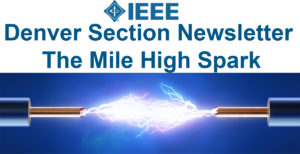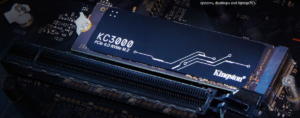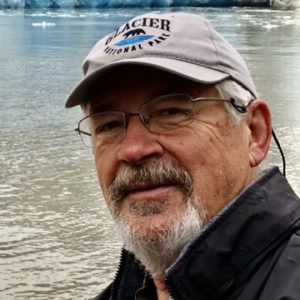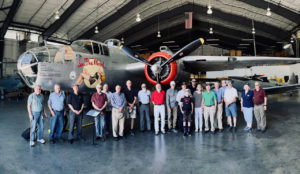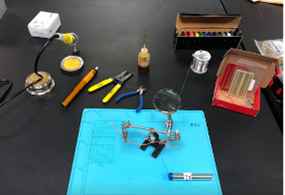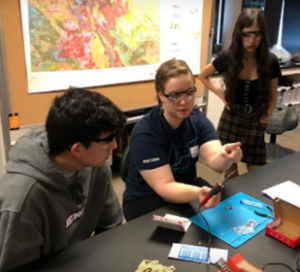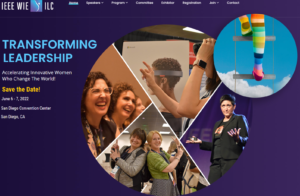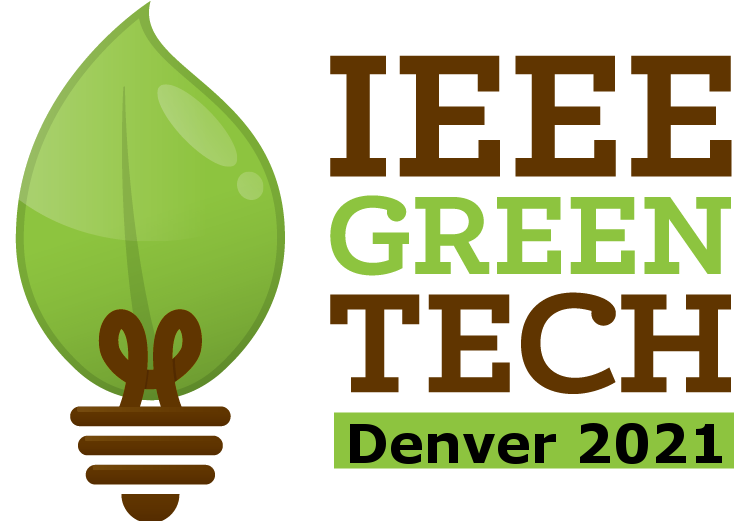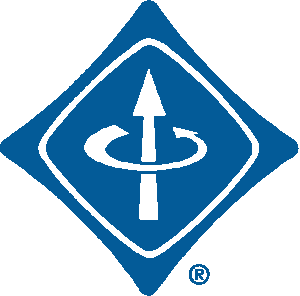 |
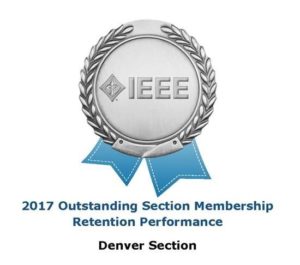 |
| New! – eBooks
Engineering for Advanced Radar and Electromagnetic Spectrum Operations Mastering Millimeter-Wave Communications Circuit Design Wireless Research Handbook: 3rd Edition Private Networks for Utilities And Energy Companies Software-Defined Vehicle: Four Core Pillars Driving Auto Industry to Change |
In This Issue Message From the Chair Editor’s Column The Build Something Cool Event Conferences/Summits/Call for Papers/Workshops/Tutorials |
New! Cool Stuff
|
| New! – Interesting Webinars |

Jan/Feb 2022 Volume 13 Issue 1
|
GET INVOLVED!!
Whether you are active in IEEE ExCom, are a chair of a
 technical society, or just a paying member, we thank you for being a part of something that we think is pretty great. If you want to get more involved, you know where to find us! And if you just want to enjoy the hard (and not-so-hard) work of our volunteers by attending our events we would love that even more! Take advantage of the monthly volunteering efforts we have put together for you. Try something new, meet some new people, and learn something new by listening to a distinguished lecturer. Oh, and thank you for being a reader of our newsletter! technical society, or just a paying member, we thank you for being a part of something that we think is pretty great. If you want to get more involved, you know where to find us! And if you just want to enjoy the hard (and not-so-hard) work of our volunteers by attending our events we would love that even more! Take advantage of the monthly volunteering efforts we have put together for you. Try something new, meet some new people, and learn something new by listening to a distinguished lecturer. Oh, and thank you for being a reader of our newsletter! |
|
Local Events News Interesting Links
|
Follow IEEE-Denver on Social Media! |
| AGL eDigest Newsletter – Current Happenings in the Wireless Space | 6G world – A Look Into the Next Generation of Wireless |
Hot Topics
| On the Edge – Osaka University Creates AI Supercomputer | Insight – Optimizing Emi Input Filters for Switched Mode Power Supplies |
| Guest Column – 11 Myths About Analog Compute | Tech Talk – Three Ways to Design A Low Quiescent-Current (Iq) Automotive Reverse Battery Protection System |
| Technical Articles, Reports, App Notes, and While Papers |
| Smart Home Technologies: Applications, Security Risks, and Scaling Challenges. By Marina Bochenkova |
| How to Boost Power Density in Automotive Systems. By Steven Taranovich |
| Designing Tomorrow’s Li-ion Battery. By Siemens Digital Industries |
| An Analysis of Cybersecurity Attacks Against Internet of Things and Security Solutions. By Mohammad Rafsun Islam1, K. M. Aktheruzzaman |
| Thermal Management Solutions for Automotive and Mil/Aero. By Joseph Forbes Petri |
| Mastering Millimeter-Wave Communications Circuit Design. A Keysight Technologies White Paper |
| 5G Evolution – On the Path to 6G. By Dr. Nishith D. Tripathi, Dr. Jeffrey H. Reed |
| 70 Technology Trends That Will Shape 2022. An ABI Research Report |
| Next Generation Cloud Computing: New Trends and Research Directions. By Blesson Varghese |
| Low-Dropout Regulators Explained. A Design News Reprint |
Follow IEEE-Denver on Social Media!Follow along with the local events and happenings of your IEEE Denver section by subscribing on social media. And don't forget to "like" and share your favorite posts!
-Facebook Page- –LinkedIn Group- –LinkedIn Page-
| Message from Jim Sipes, Chair, IEEE Denver Section, Jim Sipes – jsipes@ieee.org
Happy 2022! Well, a new year, and hopefully a new beginning. We hope the current downward trend of Covid continues… Some other good news — The IEEE Fellows Class of 2022 has been released, and four members of the Denver Section are included. The new Fellows are:
Congratulations to all! The most recent meeting of the panel that reviews applications for elevation to Senior or Life Senior Member met on February 19th. Although the official list of those elevated was not available at the time of this writing, my preliminary analysis indicates that we have nine new Senior Members in the section. I’ll update this next time when the official results are available, but, again, congratulations to all of the new Senior Members! The next meeting of the SM panel will be on April 23, and applications for consideration must be in by April 16. If you are interested and feel you are eligible for the upgrade, the requirements are set out on the IEEE website at https://www.ieee.org/membership/senior/senior-requirements.html, and we have a list of existing Senior Members who have volunteered to serve as references for those seeking the upgrade. If you want to proceed, please contact me at chair@ieee-denver.org or Jeff Hardy at vice-chair@ieee-denver.org. Speaking of appointments and elevations, at the February meeting of the Section Executive Committee, the ExCom voted to approve Jeff Hardy as Chair-Elect. So at the beginning of 2023, Jeff will take over this chair. Congratulations to Jeff! And while we’re on this topic, in late summer our current Past-Chair, Jason Rupe, will be canvassing the section for candidates to stand for Section Officer positions in our fall elections. So, if you are interested in becoming involved at the Section level, be thinking about if you would like to throw your hat in the ring. You should have by now received the premier issue of the Region 5 newsletter. This monthly newsletter is part of the new Region 5 Director, Bob Becnel’s, plan to improve communication within the region. Another way to stay connected with the region is by joining the Region 5 IEEE Collabratec Community. This Collabratec Community is open to all members of Region 5. More details at https://ieee-collabratec.ieee.org/app/community/1314/IEEE-Region-5/activities. As always, we continue to have many opportunities to contribute as a volunteer to the Section or your Chapter/Group of choice, and all are welcome at the monthly ExCom meetings on the third Tuesday of the month (except December and July). I am hoping that beginning with the April meeting we can go to a hybrid format with some attending face-to-face but with an online virtual option as well. There is a listing of the current chapters and groups supported by the Denver Section on the Section’s website, https://ieee-denver.org, under the menu heading Denver Groups. Contacts for each of the chapters/groups are available on the individual chapter/group websites. Until next time, stay safe. Jim From the Editor’s Desk, Ernest Worthman – ernest_worthman@ieee.org Elon Musk’s SpaceX loses some LEO satellites to a geomagnetic storm When I first read that a batch of Elon Musk’s satellites got fried in a geomagnetic storm I had to chuckle. But all humor aside, we seem to forget, sometimes, that there are risks to satellites as well as benefits from them. My first thought was, “how is it that Starlink loses satellites and nobody else does?”. It seems that same geomagnetic storm had to hit other satellites as well. Were the Starlink satellites the only ones in the direct path? The size of the storm was massive, much larger than the size of the earth, so it seems unlikely no other satellites were in the path. Yet Starlink’s were the only ones affected. This was all over the news, syndicated networks, the BBC, CNBC, Yahoo, streaming news outlets, some industry publications, even YouTube. I guess this garnered more attention than I would have surmised. But, when one thinks about it, this is something that can present significant issues with wireless data reliability, cybersecurity – perhaps even to life and limb in the future if the number of satellites predicted comes to fruition. Today, as we are all aware, the satellite industry, particularly the non-geostationary orbit (NGSO) Systems, or LEOs, is making a big-time play for a piece of the wireless network pie. It sees itself as becoming an integral component of the wireless ecosystem, particularly with 5G and even more with B5G. If these NGSO satellites want to be of the wireless future, they have some interesting challenges to address. Perhaps the most pressing is falling out of the sky for one reason or another. First of all, when all is said and done, some in the industry say there could be 100,000 satellites of all types up there by 2030 (according to astronomy.com). That is a boatload of space hardware. Granted, space is pretty big, but I have to think that with that kind of density in the same orbit space things are going to get messy at some point. While there has not been much said publicly about this, one issue that is becoming very visible is the risk of collision, both with other satellites and with space junk. Warnings are beginning to sound. NASA is raising red flags with Starlink’s ambitions to orbit 30,000 plus NGO satellites. In a recent letter to the FCC, NASA wrote that “With the increase in large constellation proposals to the FCC, NASA has concerns with the potential for a significant increase in the frequency of conjunction events and possible impacts to NASA’s science and human spaceflight missions.” Cool, now we are calling collisions “conjunctive events.” Oh well, another government moment of terms to make it sound like a non-issue. But imagine the potential challenge of keeping 100,000 active satellites if predictions are correct, from getting tangled up with each other, or space debris. According to astrobites.org, with just 65,000 satellites in NGSOs, the odds of a collision with a relatively large (>1 cm) fragment, which would cause severe damage to a spacecraft in a collision, would be roughly 30 percent. Taking into account smaller fragments down to 3 mm, this probability approaches 100 percent. So, this becomes a front-page issue since it will be an ongoing condition. Add to that derelict satellites (currently there are over 2200 non-operational satellites still up there), planet fragments, other space junk, aliens (hopefully they can vaporize them with their disruptor beams before they pummel their spacecraft), the odds of avoiding a conjunctive event are slim to none. Voices are being raised. In fact, some of those voices have been raising for years, even before the first conjunctive event in 1996. That was when an Iridium 33 satellite and the defunct Cosmos 2251 satellite became V’ger (watch Start Trek, the Motion Picture if this does not ring a bell) at an altitude of 470 miles. Fast forward to today and there was the recent incident between the Chinese space station and a Starlink satellite. Nothing happened but it was close enough to be a close call. There have been other satellite-to-satellite as well as some satellite-to-space rock, collisions. So far, the number is not significant, but when 60,000 to 100,000 birds are flying around up there, it would be foolish to think it is not going to happen and become a major concern. So, what happens when a satellite is banged by something? Sometimes, nothing. Other times the event may kill it, or part of it but it remains in orbit. Or it may shoot off into deep space or end up hurtling towards the earth, with everybody hoping it burns up in the atmosphere (which happens most of the time but not always). The worst case is that the conjunctive event sends it careening off, uncontrollably, in one of the NGS orbits or another populated orbit. What if that worst-case sets off the e+at scenario? In other words, it starts a chain reaction, and we have satellite billiards. So, are there solutions? For the immediate future (a couple of years, or so), we probably do not have a lot to worry about. However, if even half of the 100,000 satellites end up there, it will be a problem. The industry has been working on various collision avoidance programs because that is about the only solution (or shoot the offender out of the sky with onboard laser or missile systems). All kidding aside, there are lots of ways to go about that but only one outcome – move them out of harm’s way – however that gets accomplished. Ultimately, one wants the satellites to be “smart,” be aware of each other, and play nice when it comes to keeping track of one another. That will certainly have to come about, and they can adjust orbits dynamically as conditions demand without human overwatch. But the real issue is about objects that do not have self-awareness. That is a problem in the autonomous vehicle space as well. So, these satellites will not only have to know where everybody is but be able to spot that two-mile-wide space rock heading right for it (at a leisurely 25 km/sec). Or human space debris from a just-occurred, nearby conjunctive event. Maybe even have to dodge that recent flush of frozen human waste from a spacecraft or station. Of course, using radar and other sensing platforms should provide pretty good protection. But what if that one in a hundred, or thousand, or million, event happens? Is there a scenario for a mass failure of devices such as the recent 40 or so Starlink satellites summarily executed by the geomagnetic storm? What if such a coronal mass ejection (CME) takes out hundreds or thousands of satellites? Sure, there is hardening against, and a priori knowledge of, such events but what if the CME so often played out in sci-fi films actually comes about. Will it be possible to move thousands of satellites behind the earth in time, perfectly orchestrated? Indeed, food for thought. Recently, Samantha Fonder, NASA representative to the Commercial Space Transportation Interagency Group said that “With the potential for multiple constellations with thousands and tens of thousands of spacecrafts, it is not recommended to assume propulsion systems, ground detection systems, and software are 100 percent reliable, or manual operations (if any) are 100 percent error-free.” Hear, Hear. There is also concern from NASA about auto-maneuver capability. What if multiple constellations are auto-maneuvering in a panic while a CME is on its way? Can the industry put together a plan, with sufficient technology and cooperation among players, to orchestrate that flawlessly? So as one can see, the satellite space is far from having its ducks in a row. And this missive is just about collisions. There are all kinds of other challenges such as telescope interference and light reflections from satellites. As well, there is quite a bit of infighting going on in the industry. It will be interesting to see this unfold. And who knows when the predictions for tens of thousands of satellites will come true. The industry has a chance to get it right, still. The question is, of course, will they? Life Member Group Update
“On 12 June 2021, LMs from the Pikes Peak and Denver Sections toured the National Museum of World War II (WWII) Aviation located in hangers at the Colorado Spring Airport/Peterson Air Force Base (AFB). The museum highlighted 18 fully restored and flyable WWII aircraft along with military vehicles used during the war. The museum documents the role that military aviation played in the emergence of our nation as a world power. It tells the story of the tremendous technological advancements in aviation during WWII and the contributions and sacrifices of the men who won the air war. Our tour guide was Colonel Jim Palmer, Air Force Retired, former commander of the Third Space Support Wing, based at Peterson AFB. The LMs had lunch following the tour at the Airplane Restaurant, which is located near the airport. This unique restaurant is partially housed in an Air Force tanker airplane.” The Build Something Cool (BSC) Event Returns
Mark your calendars for Saturday April 9, 2022! Spread the word. We invite all 6-12th graders to our 7th “Build Something Cool” event at the Downtown Auraria Campus in Denver. Sidelined last year because of Covid restrictions, we are opening for business again this year with a smaller event and Covid health protocols in place, but just as much fun for everyone. Here is some information so you can volunteer a couple hours, and you might share with any kids or parents you know. Details: Who: Anyone in grades 6 – 12 and their parent(s) What: Build your own FREE project to KEEP, talk to real engineers and scientists When: Saturday April 9; 10:00 AM – 12:00 PM Where: Metropolitan State University of Denver Auraria Campus, Science Building 2001 Why: Explore electronics, learn about engineering, and do something Cool! Parents or kids can select a DIY project and register here – https://bit.ly/3vjJvVT by March 31, 2022. Volunteers – email me if you can help out two or three hours between 9 am and Noon on April 9 at jharrer@ieee.org Thank You from the BSC Planning Team: Hsiu-Ping Liu, Walt Burns, Wayne Seltzer, Jim Harrer
IEEE WIE ILC attendees are mid-to senior level professional women in technology seeking to advance their leadership skills and network with other professionals. We want the talks to reflect information or skills that our attendees need to improve their lives, whether that improvement is a new technical, management, or organizational skill. We also want our speakers to be as diverse and inclusive as our audience, so that our attendees can see themselves in the program and can see themselves as future WIE ILC speakers. For more information, click on the title link. CALL for 2022 IEEE REGION 5 AWARD NOMINATIONS IEEE Region 5 is accepting nominations for the following awards.
A short description of each award and nomination forms are posted on the Region 5 Website (ieeer5.org/awards). The same award can only be received once in three years.
The deadline for nominations is March 8, 2022. Conferences/Summits/Call for Papers/Workshops/Tutorials 24th International Microwave and Radar Conference – MIKON-2022 We would like to invite you to the 24th International Microwave and Radar Conference – MIKON-2022 at the Radisson Hotel & Suites in Gdansk, POLAND. It is exciting to have our conference in Gdansk, and we hope to repeat the success of MIKON-2014, which was also held here. Conference date: 9-11 May 2022 Again, MIKON is a part of Microwave and Radar Week (MRW), together with International Radar Symposium IRS. MIKON takes place from Monday to Wednesday (9-11 May), while the Week extends also to Thursday (12 May) with tutorials and other activities. Registration at MIKON gives you the opportunity to participate in both conferences within MRW2022. Before registering a paper, please read the submission instructions (https://mrw2022.org/instructions-for-authors). Please consider also proposing a focused session. Please visit the MRW-2022 website (https://mrw2022.org) for more information on MIKON and the exhibition. Please direct questions to Rafal Lech (Org. Comm. Co-Chair), dr.rafal.lech@ieee.org With best regards, 2022 IEEE International Conference on Communications (ICC 2022) ICC 2022 will be held in Seoul, South Korea, from 16 to 20 May 2022. Themed “Intelligent Connectivity for Smart World,” this IEEE Communications Society flagship conference will feature a comprehensive high-quality technical program in addition to an attractive industry program aimed at practitioners, with keynotes and panels from prominent research, industry and government leaders; business and industry panels; and technological exhibits. See ICC 2022 for more information. All workshop papers should be submitted via EDAS. Important Deadlines Paper Submission Deadline: 20 January 2022 Acceptance Notification: 06 March 2022 Camera-ready Submission: 15 March 2022 IEEE International Symposium on Local and Metropolitan Area Networks IEEE LANMAN 2022, a forum for presenting and discussing the latest technical advances in local and metropolitan area networking, will be held from July 11 to 12, 2022. Speculative and potentially transformative ideas are particularly encouraged, as are studies reporting measurements from real-life networks and testbeds. Papers are solicited on any topic in networking. See the above links for more information. Submissions are due March 31, 2022. EMC+SIPI Call for Submissions for the 2022 IEEE International Symposium on Electromagnetic Compatibility, The 2022 IEEE International Symposium on Electromagnetic Compatibility, Signal & Integrity (EMC+SIPI) is seeking submissions! The 2022 symposium will be held 1-5 August 2022 in Spokane, Washington. In addition to the many technologies this conference covers that may be of interest to you, you are also eligible to receive the discounted IEEE Electromagnetic Compatibility Society (EMC) Member rate to attend since you are a member of an EMC Sister Society. Please see the above links for symposium topics and other pertinent information and registration. If you have expertise in these areas, please contribute to the technical program! Learn more about all possible topics of interest and technical areas here. Papers, proposals for special sessions, workshops, tutorials, experiments and demonstrations can be submitted using our portal: www.emc-sipi2022.abstractcentral.com Key Dates
Signal & Integrity is Now Open! Receive a discounted rate to attend as an EMC Sister Society member. Call for Nominations: 2023 IEEE MGA Leadership Positions // Deadline 15 March The IEEE Member and Geographic Activities (MGA) Nominations and Appointments (N&A) Committee is soliciting nominations for the following 2023 leadership positions: – MGA Vice President-Elect/Board Chair-Elect; – MGA Treasurer -MGA Vice Chairs: Geographic Unit Operations; Information Management; Member Development – Committee Chairs: Admission and Advancement (IEEE); Awards and Recognition; IEEE.tv Advisory; Life Members (IEEE); Member Benefits Portfolio Advisory; Membership Recruitment and Recovery; Potentials Editorial Board; Student Activities; Training; vTools; Young Professionals (IEEE) Th deadline to submit nominations for the above positions is 15 March 2022. A complete list of available MGA positions, committee descriptions, and information on the MGA Nominations and Appointments process are available. Nominate yourself or a colleague now The Global Symposium on Millimeter-Waves & Terahertz (GSMM) will be held on 18 – 20 May, 2022 in Seoul, Korea. GSMM is an annual forum for researchers, engineers and practitioners to present and discuss recent breakthroughs, innovations and emerging techniques in the fields of millimeter-wave and terahertz sensing and communications. This waveband is very important in various applications to improve industry and the advancement of the human life. Millimeter-waves & terahertz technologies are applied widespread to 5G networks, communications, measurements, medical care, biochemistry, and other fields. Under the symposium theme, New Wave Technology for New Normal Life, it will cover millimeter-wave and THz electronics, antennas, circuits, devices, systems and applications. Important Dates
6 March 2022
31 March 2022
GSMM Call for Papers Announcement – *Contact us* IEEE International Conference on High Performance Switching and Routing (HPSR) The IEEE International Conference on High Performance Switching and Routing (HPSR 2022) will be held virtually and in person 6–8 June 2022 in Taicang, Jiangsu, China. The main focus of HPSR 2022 – the 23nd edition of HPSR conference – will be to assess how breakthrough changes occurring to networks and telecom are affecting areas related to switching, routing, computing and communication networks in general. We are soliciting original and thought-provoking works on big data, data analytics, cloud/edge services, and machine-learning techniques applied to networking, computing, switching and routing. Works on autonomous networks, 5G and beyond, IoT, Industry 4.0, social networks, satellite and space networks, cybersecurity, virtualization, and other advanced topics are also welcome. Paper Submission Deadline: 20 February 2022 IEEE International Conference on Communications, Control, and Computing Technologies for Smart Grids 2022 (SmartGridComm) 25–28 October 2022 // Singapore // Virtual The 2022 IEEE International Conference on Communications, Control, and Computing Technologies for Smart Grids (SmartGridComm 2022) will be held 25–28 October in Singapore and online. Prospective authors are invited to submit original papers using EDAS (under the track “SmartGridComm 2022”) on all aspects of communications, control and computing technologies for smart grids covered by the four technical symposia. Paper Submission Deadline: 10 June 2022 IEEE Global Communications Conference IEEE Global Communications Conference (GLOBECOM) will be held in Rio de Janeiro, Brazil, from 4-8 December. Themed “Accelerating the Digital Transformation through Smart Communications,” this flagship conference of the IEEE Communications Society will feature a comprehensive high-quality technical program including 13 symposia and a variety of tutorials and workshops. GLOBECOM 2022 will also include an attractive Industry program, with keynotes and panels from prominent research, industry and government leaders, business and industry panels, and vendor exhibits. Important Deadlines Symposium Paper Submissions: 15 April 2022 (23:59 EST) (FIRM) Workshop Paper Submissions: 15 July 2022 In addition to symposium papers, we are currently accepting submissions for workshop papers. GLOBECOM 2022 will feature a series of half and full-day workshops. The aim of the conference workshops is to emphasize emerging topics that are not specifically covered in the main symposia. Each workshop may include a mix of regular papers, invited presentations, keynotes and panels that encourage the participation of attendees in active discussion. IEEE International Symposium on Personal, Indoor & Mobile Radio Communications; 12–15 September 2022 // Virtual The 2022 Annual IEEE PIMRC will be held virtually 12-15 September 2022. IEEE PIMRC 2022 welcomes contributions reporting original research results in all areas of wireless technology as well as in applications, services, and business. Prospective authors are invited to submit technical papers of their previously unpublished work. All accepted and presented papers will be submitted to IEEE Xplore. Topics of interest should be included within the following Tracks: Track 1: PHY and Fundamentals Paper Submission Deadline: 25 March 2022 The Fourteenth Annual IEEE Green Technologies (GreenTech) Conference March 30 – April 3, 2022 | Houston, TexasCALL FOR PAPERS From March 30th- April 1, 2022 in Houston Texas, IEEE will host the 14th Annual IEEE Green Technology Conference (GreenTech 2022) where professionals will partner with industry leaders to showcase innovative solutions to one of the most important questions of the 21st century. The IEEE Green Technology Conference (GreenTech) was developed to address one of the most pressing challenges of our time: to produce green and clean energy in the 21st century to help conserve the environment.
The conference is using the EDAS (www.edas.info) system for paper submission. The link to submit papers to in EDAS system is https://edas.info/N29291 Alternatively, an author can go to www.edas.info and search for the GREENTECH 2022 or 2022 IEEE Green technologies Conference (GreenTech). Authors may submit papers up to six pages and are allowed two additional pages at a cost. The conference deadlines are as follow:
Authors are required to present their paper at the conference in order for a paper to appear in the conference proceedings. IEEE reserves the right to exclude a paper from distribution after the conference, including IEEE Xplore Digital Library, if the paper is not presented by the author at the conference. Any exceptions to this policy can only be made by the Conference Chairs. The 2022 GreenTech Committee is looking forward to receiving your exciting works. Sincerely, Bradley Updyke, Conference Chair You can see all of our upcoming events on the IEEE Denver Events Calendar The IEEE Denver Section is comprised of over 3600 engineers and technical professionals in the Denver – Boulder area. Mission Statement Enrich the professional and personal lives of the Rocky Mountain Region members, developing them into valued contributors to society through quality programs, continuing education, career development and community service; in collaboration with IEEE, industry, government and academia.
|
|
|
|


